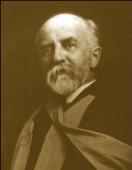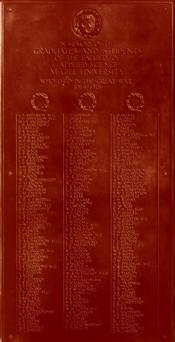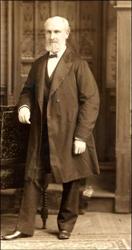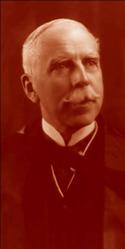1954
For the first time in 25 years, Mechanical Engineering revises its curriculum. The revisions emphasize mathematical and engineering analysis over technique, practice and the engineering sciences.
1956
George Boyd Webster (BSc 1904), mining engineer and financier, endows a Chair of Mining in his name.
1957
One-quarter of all undergraduates at McGill are registered in Engineering.
Mechanical Engineering introduces Mechanical Sciences as a new option. Later, this was renamed the Honours curriculum to conform to similar programs in Civil and Electrical Engineering.
1958
Named in honour of J.W. McConnell, a Governor of the University from 1927 to 1958, the new four-storey McConnell Engineering Building is officially dedicated by Chancellor Ray Edwin Powell on October 6, 1958. The new building doubles the Faculty’s space and provides much needed facilities for graduate programs.
The new Chair of Electrical Engineering, G.L. (John) d’Ombrain, introduces the first computer to McGill.
1960
Quebec Premier Maurice Duplessis accepts federal transfer payments, thereby ushering McGill into the new era of public funding and government-subsidized education. That same year, the federal government freezes tuition fees and increases the number of graduate and foreign students admitted.
1961
L.C. Lu becomes the first woman to earn a Chemical Engineering graduate degree. Not until 1972 would the department award another graduate degree to a woman.
The Department of Mining Engineering changes its name to Mining Engineering and Applied Geophysics.
Chemical Engineer Major James Henry Brace bequeaths funds for the establishment of an institute that will research desalination, and ways for large quantities of water to be brought to arid lands for food production and rural development. The Brace Research Institute is established at Macdonald Campus.
1963
A mezzanine floor is added to the Civil Engineering laboratory in the Macdonald Engineering Building, permitting the construction of a dedicated laboratory for Sanitary Engineering. This is the predecessor of the Environmental Engineering Lab.
1965
The option of Engineering Physics is discontinued in Electrical Engineering.
1966
First-ever renovations are performed on the Macdonald Chemistry and Mining Building.
Eric Adler, Assistant Professor in the Department of Electrical Engineering, completes the PhD he had been working on since first being hired in 1961. Adler’s research on surface acoustic waves (SAW) is no small matter. The SAW research he conducted with Gerald W. Farnell (PhD 1957) informs much of the subsequent growth of SAW into a major industry. The filters and signal processing devices for applications in communications devices such as televisions and cellular telephones are based on their publications, which remain seminal.
1967
McGill alumnus Robert Shaw is widely acknowledged as the man behind the realisation of Montreal Mayor Jean Drapeau’s vision for Expo ’67, the world’s fair in Montreal. Still widely considered to be Canada’s finest moment, the fair was organized in just three short years after the acceptance of Jean Drapeau’s bid to replace the Moscow world’s fair, cancelled by the Soviet Union in 1964. Known as a great businessman and enthusiastic lover of life, Shaw would also earn the respect of McGill’s student body during a time of social unrest. In his capacity as Vice-Principal of Administration, a position he held until 1971, he is credited for his empathetic handling of the “McGill français” riots, and for showing tolerance and respect for the most radical and marginal of students.
1968
With its four new floors built the previous year, the McConnell Engineering Building is officially re-opened. To inaugurate the new Computer Centre, the word "OPEN" is spelled on a teletype machine linked to the computer on the fourth floor.
1969
The opening of Quebec’s post-secondary community colleges, the CEGEPs (Collèges d’enseignement général et professionnel) necessitates the revamping of all the Faculty’s programs. Because CEGEPs provide for two years of free preuniversity or three years of vocational training, the needs of incoming students from Quebec change significantly.
The School of Computer Science is established to grant graduate degrees. In 1997 the school would move to the Faculty of Science.
Of the students in the Faculty, 98 percent are male and 2 percent are female during the 1969-70 academic year.
Undergraduates gain the right of representation at Faculty meetings. Along with the EUS President and EUS Chair of the Educational Committee (now known as the Academic Committee), each academic unit is allowed to send a representative. In 1970 graduate students also gain the right of representation.
1970
Responsibility for administration of the Faculty is distributed to include three Associate Deans: Academic (Thomas Barton); Student Affairs (William Bruce); and Development (Tomáš Pavlásek, BEng Electrical 1944, MEng 1948, PhD 1958).
1971
The post-CEGEP entrance requirements emerge with individual departments requiring between 100 and 105 credits. Departments require non-Quebec applicants to complete an additional 30 credits (the pre-university or "U-0" requirements).
Colombian-born Alvaro Ortega, a graduate of the School of Architecture (BArch 1964) and professor at McGill, establishes the Minimum Cost Housing Program to study and research housing conditions in developing countries.
1972
For the next eight years until his death in 1980, Victor Fangor, a recently retired engineer, volunteers his services with Mechanical Engineering. He provides invaluable practical knowledge and shares with students, staff and faculty his vast storehouse of knowledge.
1973
Another chapter is added to the overlapping and intimate relationship between Mining and Metallurgical Engineering. Having been joined in 1871, separated in 1901, reunited in 1937, split apart again in 1947, they put aside their differences and agree to get back together.
The School of Urban Planning hires the Faculty’s first ever female professor – Jeanne Wolfe (MA 1961). A decade would pass before the Faculty would hire the second – Sue Whitesides in Computer Science. Reinforcements to these two pioneers finally came in the early 1990s with Annmarie Adams (BA 1981) in Architecture, Laurie Hendren in Computer Science, Jana Simandl (BEng Chemical 1982) in Chemical Engineering, Ghyslaine McClure in Civil Engineering, and Hanna Michalska in Electrical Engineering.
1974
Chemical Engineering graduates its first female PhD – Thi Huong Nguyen-Doan (MEng 1970).
1975
Judy Pharo is hired to fill the newly created position of Student Advisor in the Dean’s office.
1976
Derek Drummond (BArch 1962), William Macdonald Professor of Architecture, is chosen Director of the School of Architecture. He holds the position until 1985 and for a second term from 1990 to 1996, when he becomes Vice-Principal, Development and Alumni Relations.
1978
The Computer Engineering Option (BEng Electrical) is introduced. Additionally, the Minor in Computer Science makes its debut even though there was still no undergraduate program dedicated to Computer Science.
Eric Adler becomes the new Associate Dean (Academic). Monty Newborn becomes the Director of the School of Computer Science. Phil Harris and Pierre Bélanger (BEng 1959) become, respectively, the new Chairs of Civil and Electrical Engineering.
Jules Stachiewicz, professor of Mechanical Engineering from 1950 and Chair of the Department from 1972 until his death in 1976, is honoured posthumously with the first Canadian Heat Transfer Medal. Subsequently renamed in his honour, the Jules Stachiewicz Medal is given in alternate years by the Canadian Society for Chemical Engineering and the Canadian Society for Mechanical Engineering in recognition of outstanding achievements by a person working in Canada in the field of heat transfer.
The Macdonald Chemistry and Mining Building is renamed the Macdonald-Harrington Building in honour of Bernard James Harrington, who taught Chemistry there from 1847 to 1907. He had helped plan the original structure with the building’s donor, Sir William Macdonald.
1979
The Faculty of Science introduces an undergraduate honours program in Computer Science.
Engineering formalizes a Minor in Management Option (management courses were already available).
The Department of Mechanical Engineering awards its first PhD in Production Engineering to M. Helmi Attia.
1980
McGill alumnus Val Fitch (BEng Electrical 1948, DSc 1987) wins the Nobel Prize in Physics for the discovery of violations of fundamental symmetry principles in the decay of neutral K-mesons. The prize is shared with his colleague, James Cronin.
1981
Under the leadership of Director David Farley (BArch 1959), the School of Urban Planning officially becomes a separate unit. Since moving to the Faculty from Graduate Studies in 1976, the School had been listed separately in the course calendar. The School is recognized by the Ordre des Urbanistes du Québec and the Canadian Institute of Planners.
Mechanical Engineering adds the Aeronautical Engineering Option.
Electrical Engineering introduces a Minor in Physics.
John Gruzleski becomes Chair of Mining and Metallurgical Engineering.
Engineering alumni demonstrate through their generosity the quality and value of McGill Engineering teaching. First, the Class of 1938 creates and sponsors until 1985 a Teaching Award. This award was taken over by the Class of 1951 until 1994, when it became known as the Alumni Award for Outstanding Teaching. That same year, the Class of 1944 endowed its own award which remains known as the Class of 1944 Outstanding Teaching Award.
1983
The Engineering Library moves from the Macdonald Engineering Building to the renovated Macdonald Stewart Building where it is merged with the Physical Sciences Library, today known as the Schulich Library of Science and Engineering.

1984
Pierre Bélanger begins the first of two five-year terms as Dean of the Faculty. In Chemical Engineering, Musa Kamal is named Chair, and Peter Silvester (PhD 1964) begins as Chair of Electrical.
Canada’s foremost chemical engineer, William H. Gauvin of Chemical Engineering, wins the Jules Stachiewicz Medal. The previous year he had been honoured by McGill with a DSc honoris causa.
The Faculty introduces its new MEng Program in Pulp and Paper.
Chemical Engineering celebrates its 75th anniversary.
1985
With a grant from the Québec Ministère de l’Enseignement Supérieur et de la Science, four researchers – Martin Levin, Steve Zucker, Pierre Bélanger, and George Zames (BEng Engineering Physics 1954)– form McRCIM (the McGill Research Centre for Intelligent Machines), now known as the Centre for Intelligent Machines, to study intelligent systems. CIM seeks to advance the state of knowledge in such domains as robotics, automation, artificial intelligence, computer vision, systems and control theory, and speech recognition.
The Macdonald-Harrington Building, constructed in 1898, is renovated at a cost of $4.5 million.
The construction of the 8th floor addition to the McConnell Engineering Building is approved at a cost of $170,000.
The Department of Chemical Engineering and the Faculty of Science’s Biology Department introduce a biotechnology minor. Chemical Engineering also establishes a new enrolment record that year with 68 students at the undergraduate level and 23 at the Master’s level. The latter is the first group to graduate from the MEng (non-thesis) Program.
The Faculty introduces a Minor in Mathematics.
In honour of her late brother George G. Ulmer Jr. (BSc Chemical Engineering 1917), Eugenie Ulmer Lamothe of Minneapolis, Minnesota, creates a memorial fund in his name. The remainder of the gift stipulates that all funds be used to benefit Chemical Engineering and is designated in her name.
Richard Redwood is named Chair of Civil Engineering.
1986
R.I.L. Guthrie is named the William C. Macdonald Professor of Metallurgy.
The Faculty makes a major modification to the Complementary Studies requirement for all the BEng programs; study of the impact of technology on society becomes mandatory.
Jim Provan is named Associate Dean (Academic); Abdul Ahmed (MEng 1964, PhD 1971) becomes Chair of Mechanical Engineering; Bruce Anderson (BArch 1964) is appointed Director of the School of Architecture; and Renato de Mori is named Director of the School of Computer Science.
1987
Four students each from Chemical Engineering and Biology form the first graduating class of the Biotechnology Minor (BEng).
Alberto Perez-Gomez is appointed to hold the newly created Saidye Rosner Bronfman Chair in Architectural History. He institutes a new graduate program, History and Theory of Architecture.
Canadian Mining Hall of Fame inductee and McGill honorary degree recipient Gerald G. Hatch (BEng Metallurgy 1944, DSc 1990) endows a Chair bearing his name in Mining and Metallurgy. Hatch retired in 1990 but not before the small consulting firm he started with six employees in 1958 won the Governor General’s Award for Excellence for implementing the process of direct reduced iron as a feedstock for electric furnace steelmaking. John Gruzleski is named the inaugural chairholder.
The School of Architecture moves into the renovated Macdonald-Harrington Building.
Three floors of the McConnell Engineering Building are renovated.
The faculty introduces a Minor in Economics.
1988
Three research centres with active participation by Chemical Engineering staff are established: Polymer McGill, Pulp and Paper Research Centre, and Centre for Bioprocess Engineering.
McGill and École Polytechnique create a joint Mining Co-op BEng Program, which ranks among the largest mining programs in Canada.
McCAD, an advanced Hewlett Packard based computer lab, opens for graduate students.
Jim Finch (MSc 1971, PhD 1973) is appointed Chair of Mining and Metallurgical Engineering.
1989
Witold Rybczynski (BArch 1966, MArch 1972, DSc 2002) and Avi Friedman (MArch 1983) reorganize the School of Architecture’s Housing Design graduate program and rename it the Affordable Homes Program.
The Faculty introduces a new BEng program in Computer Engineering. It also introduces a new, modified BEng program in Civil Engineering with a core course in Environmental Engineering; a Minor in Materials Engineering offered jointly by Chemical and Metallurgical; a Minor in Construction Engineering and Management in Civil.
The Inter-University Plasma Technology Research Centre is established jointly with the Université de Sherbrooke and the Hydro-Québec Research Institute. Plasma Technology has great potential in the areas of material treatment, chemical synthesis, extractive metallurgy and toxic waste destruction.
1990
Bryan Stafford-Smith and Nicholas Rumin (BEng Electrical 1957, MSc 1961, PhD 1966) become, respectively, Chairs of Civil and Electrical Engineering.
In collaboration with local aerospace companies, École Polytechnique and Concordia University, the Faculty introduces a Joint Master’s Program in Aerospace Engineering. Also new is a BSc Major in Computer Science (in the Faculty of Science); a Minor in Arts and a Minor in Environmental Engineering. Chemical introduces a new BEng called Program for the 21st Century or Curriculum 2000.
The Canadian Institute for Telecommunications Research, part of the federal Network of Centres of Excellence program, is founded with its base at McGill. The Institute researches current or anticipated technologies within the information and communications technology industries.
1991
A group of retired engineers join students to launch the McGill Engineering Summer Employment Program (MESEP) to help students find career-related summer jobs.
1992
Facing a 20 percent budget cut from the provincial government, the Faculty produces a comprehensive planning document titled "Strategic Planning in the Faculty of Engineering: A Framework, 1992-1995."
The IYES (Internship Year for Engineering and Science) program begins. Students receive academic credit for 8, 12 or 16 months as interns in industry.
John J. Jonas (BEng Metallurgy 1954) is appointed Henry Birks Chair in Physical Metallurgy.
1993
A group of ten students in the Department of Mechanical Engineering design Quebec’s first solar car. They call it Ra Power in honour of the Egyptian Sun god. At SunRayce ’93, Ra Power finishes 11th overall, the highest of any Canadian entry.
Ron Neufeld (BSc 1973) ecomes Associate Dean(Academic) and Robert Japp (BEng Civil 1960, MEng 1964, PhD 1967), is appointed Associate Dean (Student Affairs).
1994
John Dealy becomes the first Chemical Engineer to hold the position of Dean of the Faculty. Also Vince Thomson is appointed inaugural Werner Graupe Professor of Manufacturing Automation; Richard Munz (PhD 1974) is appointed Chair of Chemical Engineering; and Patrick Selvadurai becomes Chair of Civil Engineering.
Chemical Engineering implements a Minor in Chemistry.
1996
Engineering’s Vince Thomson and the Faculty of Management’s Vedat Verter co-direct the newly established Master of Manufacturing Management Program.
In celebration of the 175th Anniversary of McGill, the bronze statue of James McGill, designed by sculptor David Roper-Curzon, is unveiled on lower campus. The School of Architecture’s David Covo (BSc Architecture 1971, BArch 1974) chaired the project committee and much of the actual work was conducted in the School’s workshop.
The Quebec Department of Education approves McGill’s application to offer a PhD in Architecture.
A Design Option in BEng (Mechanical) is offered, and the program of study is substantially modified.
Stuart Price becomes Chair of Mechanical Engineering.
Architecture’s Affordable Homes Program introduces Next Home, an updated version of Grow Home. Like its predecessor, it offers affordable housing through innovative design and construction methods.
1997
The new M.H. Wong Building – the first new major academic construction on McGill’s downtown campus in almost 20 years – is erected around the Foster Radiation Laboratory (built in 1948). The building, which became the new home of the Departments of Chemical and Mining, Metals, and Materials Engineering cost close to $34 million, $12 million of which came from private donations. The largest of these was a gift of $8 million from the family and friends of the late Man Hung (Jimmy) Wong (BArch 1981). Another anonymous donor from Hong Kong contributed $1.9 million in honour of the late Chemical Engineering professor J.B. Philips.
28 students register in the new Metallurgical Co-op Program, patterned on the Mining Co-op Program.
The Faculty creates an interdepartmental MEng in Environmental Engineering. Van Nguyen of Civil Engineering is the inaugural program coordinator.
Robert Japp (BEng Civil 1960, MEng 1964, PhD 1967) is named Chair of Civil Engineering; Frank Mucciardi (Metallurgy 1974, MEng 1977, PhD 1981) becomes Associate Dean (Student Affairs); and Arun Misra is appointed Associate Dean (Academic).
The School of Computer Science leaves Engineering to join the Faculty of Science.
1998
The Department of Electrical Engineering changes its name to the Department of Electrical and Computer Engineering (ECE). David Lowther is named Chair of the Department that attracted 52 percent of all applications to the Faculty that year.
The McGill Engineering Career Centre (MECC) is created, merging the career services offered by IYES, CAPS (Career and Placement Services) and MESEP. McGill’s first PhD in Architecture is awarded to Lily Chi who would become an associate professor at Cornell University.
Faculty students and staff write and adopt a code of conduct called "The Blueprint" to better foster a sense of community and improve the Engineering environment.
The Blueprint says:
- As a member of the McGill community, I will practise personal and academic integrity.
- I will strive to achieve academic excellence through honest effort and continuous evaluation of my goals.
- I will respect the rights and dignity of all individuals and treat all persons with honesty, respect, fairness and compassion.
- I will remain committed to the equal rights and opportunities of all persons.
- I will encourage participation in extracurricular activities to foster a sense of community within the Faculty.
- I will treat University property with respect and pride to ensure that our physical environment is conducive to learning and study.
1999
A metallurgist specializing in aluminum, John Gruzleski of the Department of Mining and Metallurgical Engineering, becomes the Faculty’s twelfth Dean.
Julie Payette (BEng Electrical 1986, DSc 2003) flies in space, the third McGill graduate and the first from Engineering to do so. She serves as mission specialist aboard the Space Shuttle Discovery as part of the mission STS-96. The crew performed the first manual docking of the Shuttle with the International Space Station.
The Brace Research Institute merged with the Centre for Drainage and Water Management of the Faculty of Agricultural and Environment Sciences to form the Brace Centre for Water Resources Management. The Centre is jointly administered by Engineering and Agricultural and Environmental Sciences.
The Faculty introduces a Minor in Software Engineering; in collaboration with the Faculty of Management it also introduces a Minor in Technological Entrepreneurship.
Denis Mitchell is appointed the seventh William Scott Chair in Civil Engineering.
Jeremy Cooperstock, of the Department of Electrical and Computer Engineering and member of the Centre for Intelligent Machines, inaugurates the McGill Intelligent Classroom, a highly sophisticated electronic classroom, located in Room 13 of the McConnell Engineering Building.
2000
Quebec entrepreneur Lorne Trottier (BEng 1970, MEng 1973) announces a gift of up to $5 million to help build a new Information Technology undergraduate teaching facility at McGill, estimated at a cost of $17 million. Trottier is co-founder of Matrox Graphics Inc., a privately held Montreal-based graphic chip designer and card manufacturer that employs 1,200 people around the world.
Female students account for 26 percent of the Faculty’s undergraduate student population.
2001
The government of Quebec announces that it will provide $7 million to complete the Lorne M. Trottier Building, prompting Trottier to double his gift to $10 million. The building will help alleviate the acute overcrowding that had obliged the Department of Electrical and Computer Engineering to accept only 85 of the 500 qualified applicants to the department annually.
2002
Wagdi G. Habashi (BEng Mechanical 1967, MEng 1971), is appointed the inaugural NSERC and J. Bombardier Chair of Multidisciplinary Computational Fluid Dynamics. Habashi is Director of the Computational Fluid Dynamics Laboratory that has made important contributions to aircraft efficiency, safety and performance.
Gordon Roberts, a James McGill professor of Electronic and Computer Engineering, makes significant advances in mixed-signal Microelectronic chips testing. The Microelectronics and Computer Systems (MACS) Laboratory of which Roberts is Director receives approximately $2.5 million from the Canada Foundation for Innovation.
2003
The Lorne M. Trottier Building opens in September. The building houses six floors of advanced teaching laboratories, interactive learning rooms and meeting spaces and is equipped with all of the latest high-tech equipment.
Reghan Hill is appointed Canada Research Chair in Colloids for Advanced Materials. An expert in colloids (derived from the Greek word for glue), Hill was appointed assistant professor in the Department of Chemical Engineering in 2002.
As a result of a $7 million grant awarded by the Natural Sciences and Engineering Research Council of Canada, the Department of Electrical and Computer Engineering establishes a five-year research project called the Agile All- Photonics Networks. Led by founding professor David Plant and with the involvement of ECE professors Andrew Kirk, Lawrence Chen, Mark Coates, Lorne Mason, and Richard Vickers, the project’s engineering innovation involves increasing the effective capacity of the Internet through all-photonic switching.
The City of Montreal approves a three-year protocol d’entente with the schools of Architecture and Urban Planning at McGill and Université de Montréal. The agreement provides funding while involving students in major urban planning projects. The first of these was a competition to develop a Montreal parking lot as part of a new public space to be known as Quartier des Festivals. The winning project, Lumière, Lumineuse, Illuminée, was from an inter-university team that included McGill architecture student Yi-Ting Hui.
The Canadian National Institute for the Blind presents Vincent Hayward, Director of the Centre for Intelligent Machines, with the E. and Mary Hochhausen Award ($10,000) for work towards developing an affordable Braille display for computers.
The Water Research Network, part of the Canadian Climate Impacts and Adaptation Research Network (C-CIARN), launches from the Brace Research Institute. Headed by Brace Director Chandra Madramootoo, the program is an innovative, multidisciplinary look at the vital question of water management.



